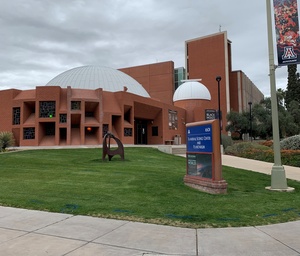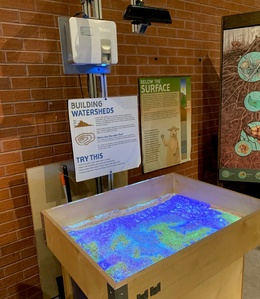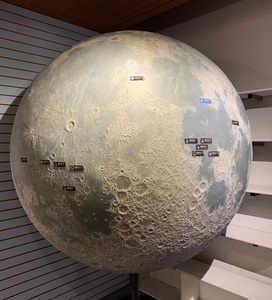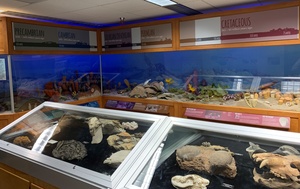The Flandrau Science Center and Planetarium is located on the University of Arizona campus at 1601 East University Boulevard. The Planetarium is open from 9am to 5pm Monday through Thursday, 9am to 10pm on Friday, 10am to 10pm on Saturday, and 12pm to 5pm on Sunday. This building holds many interesting things to do from discovering the rest of the universe, learning our solar system, examining minerals, and more. Many different events are held in this Science Center. There are eight different museums that you can visit with a shark exhibit coming soon and along with The Eos Foundation Theater to watch some fascinating shows. It costs sixteen dollars for adults, twelve dollars for children of the 4 to 17, and is half of price for students with student ID.
Flandrau Science Center and Planetarium Photo taken by Trevor Begay
Photo taken by Trevor Begay
There is a “Puzzles, Proofs, and Patterns" section. This section is an interactive exhibit where you can solve puzzles, games, and create many new things you did not know you could do. The focus of this exhibit is to challenge your mind. You figure out that math is used to solve almost all the puzzles they have. It challenges your brain to think of new ways to solve problems. This hands-on experience is great for kids to learn new things. It is also a great experience for the adults as well. It makes you think and get creative to solve the puzzles. During the walk through this exhibit you learn more about the history of math. You also learn the science behind math. Most people do not think that math is truly a science; but after experiencing the exhibit, you realized that math is a science like chemistry or biology. The patterns section of the exhibit was not just sectioned to one part of the exhibit. You notice different geometric patterns throughout the whole exhibit. With a section called the "Critical Zone" which allows people to explore, learn about the life on earth, and has activities that people can interact with. Overall this part of the Science Center can be enjoyed by young and old for a challenging interactive experience.
Critical Zone: Activity Photo taken by Trevor Begay
Photo taken by Trevor Begay
Another section of the Science Center is dedicated to the moon. It speaks a lot about the history of the moon. This exhibit also tells you the history of the years that it took to get to the moon. The University of Arizona has played a huge role in the expeditions to the moon and other space missions to discover more about the solar system. Astronomer Gerard Kuiper at the University of Arizona has a team of researchers that helps to find more about the moon and what it really was. The exhibit shows you the maps that the researchers made of the moon. Kuiper's team created the detailed map of the moon to help NASA identify lunar landing sites. You get to go through the story of this research and what Gerard Kuiper was doing during this time of exploration of the moon. The pictures that are provided in this part of the exhibit was truly something you need to see in person. It is a giant sculpture of the Moon and looks very realistic.
Moon Sculpture Photo taken by Trevor Begay
Photo taken by Trevor Begay
From Tucson To The Moon Article Photo taken by Trevor Begay
Photo taken by Trevor Begay
A great section of the Science Center that everyone needs to visit is the “University of Arizona Mineral Museum”. Walking around this exhibit is very fascinating by looking at all the different types of minerals from different areas like, gold, copper, zinc, gems, fossils and much more. "The Mineral Museum first started conducting tours during the 1950’s and continues to do so today" [2]. There are some minerals that are preferable found here in Arizona and guest can see what type of minerals live here. You learn that the minerals come from all over the place with individual names of these different types of minerals and there is a lot to try to remember the names of all of them. The Mineral Museum has so many different types of minerals to look at. After each one you do not think that it could get any better, but move to another area and another mineral can more fascinating to look at as well. The minerals in this museum have so many different colors and textures that are so appealing to look at. This exhibit is great for anyone to experience because of all the beautiful wonders that you get to see.
UA Mineral Museum Photo taken by Trevor Begay
Photo taken by Trevor Begay
The exhibit “Destination Mars” is a large scale-model of the red planet and can explore. People can learn about what probes or spacecraft that have discovered on Mars. there are little sections to read and a comparison to earth which is titled "Earth VS. Mars". A meteorite fragment from Mars can be seen at the exhibit. Take a chance to discover the red planet and what it take to get there.
Mars Wall Photo taken by Trevor Begay
Photo taken by Trevor Begay
The “Fossil Corner” of the science center was very interesting to walk through. It is a small section located in the back are of the Mineral Museum, but it is truly something to see. You get to see different life forms that were on Earth from millions of years ago. You get to see land animals and exotic sea creatures from an extremely long time ago along with some dinosaur. There are different sections of this exhibit. One of them has a beautiful display of the ocean called "Paleo Reef". The different color and fossils in the exhibit make you think that these were the creatures living in the sea at once. Another part of the exhibit is where you get to see real dinosaur bones. The shocking part about the bones is that they were found right near Tucson mountains. This experience was something because it made you think that at one point, a dinosaur was walking around the University of Arizona or in the Tucson area. There is a game a called "A Twist in Time" where you try to become a fossil [4] and the fun facts you find out during this game makes you appreciate the fossils you just saw.
Fossil Corner Photo taken by Trevor Begay
Photo taken by Trevor Begay
Right now, one section of the Planetarium is under construction for the shark's exhibit. The sharks exhibit should be opening pretty soon with a sign that states "Coming Soon" with a "February 2019" as its opening date. This part is located next to the "Puzzles, Proofs, and Patterns" section in the back. The "Sharks: Magnificent and Misunderstood" exhibit lets people get over their fears of sharks and to learn more about these creatures that live in the sea as we speak. The Planetarium and Science Center is a truly amazing experience and a must see of Tucson, Arizona if you are visiting the University of Arizona campus.
SOURCES
[2] https://flandrau.org/exhibit/ua-mineral-museum


